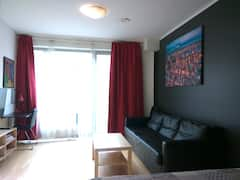Christianity has an interesting history in Lithuania full of resistance, turmoil, and bribery – with woolen sweaters. Historically, Lithuania was a pagan country with numerous rich traditions that favored chasing away winter by burning a straw effigy, for example. During the Baltic Crusades, Lithuania began to adopt Christianity while under the rule of King Mindaugas. It is even said that many Lithuanians opted to convert because they were offered woolen sweaters, which were valuable at the time.
Despite the fact that Lithuania was the last country in Europe to adopt Christianity, Lithuanians have fought for the right to practice their chosen religion (whatever it may be; Judaism and other religions are also practiced in Lithuania). However, the majority of places of worship in Vilnius were closed during Soviet occupation and used for such unusual activities as storing wine, a sports gym, or, interestingly, a museum for atheism. Many of Vilnius’ churches have now been restored to their former glory and there are currently 28 churches in Vilnius’ old town alone. Read on to learn more about five churches you should visit in Vilnius.
1) St. Anne’s and Bernardine Church Complex

My personal favorite church structure in Vilnius’ old town is the St. Anne’s and Bernardine Church Complex located on Maironio gatve near Bernardine Park and Uzupis. St. Anne’s Church is a massive red brick structure built in the Gothic architectural style. St. Anne’s Church was originally built in the 1400s in wood, but was destroyed by a fire and rebuilt in the 1500s by the Franciscan brothers.
The neighboring Bernardine Church and Monastery is also built in the Gothic style but has additional Renaissance and Baroque details.
Both of these churches can be visited, although it would be best to plan your visit to avoid church services and occasions such as weddings and baptisms as these are generally private affairs. Entrance is free although donations are appreciated.
2) Sts. Peter and Paul's Church

Though the exterior is not as stunning as other churches that you’ll see around Vilnius, including the St. Anne’s and Bernardine Church Complex, the interior is what makes Sts. Peter and Paul’s Church stand out. Upon entering this church, your eyes will immediately be drawn to the over 2,000 white, stucco statues carved into the walls, columns, and ceilings. The interior of Sts. Peter and Paul’s Church is entirely white, making it really shocking and eye-catching. Keep your eyes open for the carved, stucco statue of Death (a triumphant looking skeleton) near the entrance/exit of the church.
Located slightly outside of the old town in the Antakalnis neighborhood, Sts. Peter and Paul’s Church is an easy 10 to 15 minute walk away from the Vilnius Cathedral. Entrance is free although donations are appreciated. As mentioned above, be considerate in the planning of your visit as this is an active church.
3) The Gates of Dawn

The Gates of Dawn is one of the most important religious and historical structure in Vilnius as it is the only remaining gate of the former city wall that surrounded Vilnius old town in the 1500s. In addition to this being the only remaining gate of the historic city wall, the Gates of Dawn contains a small chapel with a golden icon of the Virgin Mary, but unusually, she is shown without holding baby Jesus. The icon itself is thought to bestow miracles, and pilgrimages are often made to see this icon.
The Gates of Dawn can be visited every day of the week from approximately 6 am until 7 pm. Feel free to call or email the addresses on the website below for additional visiting information.
You might be interested in these Airbnbs!
4) St. Mikalojaus Church

Built in the 1300s, St. Mikalojaus Church (also known as St. Nicholas’ Church) is the oldest standing church in Vilnius. This beautiful church is believed to have been built by German immigrants and is built in red brick in the Gothic style. Upon your visit, you’ll note the unusual step-like top of the exterior, which is not prevalent on churches in Vilnius. If you look closely enough, you’ll also see fingerprints in the bricks that were made during the building of the church. Just imagine how old that fingerprint is!
Similarly to the other churches mentioned above, St. Mikalojaus Church is open daily and visiting is free although donations are appreciated.
5) Vilnius Cathedral

Last but certainly not least, Vilnius Cathedral, the Cathedral Belfry, and Cathedral Square are more main sites to see in Vilnius. Vilnius Cathedral, also known as Cathedral Basilica or the Cathedral of St. Stanislaus and St. Vladislav, is one of the most important Catholic churches in Vilnius and is the host to numerous festivals and religious celebrations. It dates back to approximately the 13th through 15th century, but has been rebuilt numerous times because of issues with flooding from the nearby Neris River. Under the Vilnius Cathedral lies the remains of some of Lithuania’s most important historical figures including Vytautas the Great, King Alexander of Poland, Queen Barbora Radvilaite, and Queen Elisabeth of Austria among others.
A tour of the crypts under Vilnius Cathedral will introduce you to these important historical figures, and tours can be booked from Monday to Saturday from 10 am to 4 pm. Tours must be scheduled in advance via email or phone (see website below) and the cost varies depending on the language of the tour.
A visit to the Cathedral Belfry is also highly recommended as it affords views of the entire city – it is 52 meters tall (170.6 ft). The Cathedral Belfry was originally part of the city wall in the 13th century and some of the old tower remains today. The belfry became the Cathedral Belfry in the 16th century and was reconstructed in the 19th century and restored just recently. Visiting hours to the Cathedral Belfry vary depending on the season and is always closed on Sundays and holidays; check their webpage for up-to-date hours. Admission costs 4.50 EUR (4.72 USD) for adults and reduced tickets cost 2.50 EUR (students, teachers, and etc; 2.62 USD). Those with limited mobility or young children may be unable to visit the belfry as the stairs are quite steep and no elevator is available.
The Vilnius Cathedral itself can be visited daily and it is free to enter.
More to see
With 28 churches in Vilnius’ old town, you could easily spend your entire visit going from church to church; however, armed with this list you’ll visit the most impressive and historically relevant churches in the city. Other churches that you might want to pay attention to during your strolls around Vilnius include the Church of the Apparition of the Holy Mother, St. Nicholas Church, Church of St. Casmir, and St. Apastalu Pilypo and Jokubo Church (its bright red exterior is impressive). At Russian Orthodox churches, you may notice that women cover their hair; during your visit, you may consider covering your hair with a scarf, although it isn’t required for visitors who wish to enter.
Remember to be respectful of beliefs and traditions while visiting these places of worship and pay attention to photography rules closely. The above mentioned churches do appreciate donations to keep them running, so consider bringing some change to deposit in the designated boxes.
Enjoy your visit to the stunning Vilnius, Lithuania and visit some of its many churches!
History
Get Trip101 in your inbox
Unsubscribe in one click. See our Privacy Policy for more information on how we use your data






















Create an account to